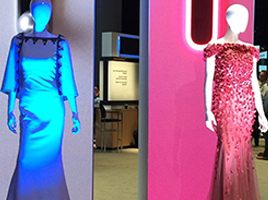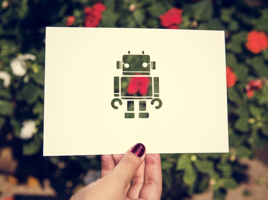
The glamorous dresses in front of me — the one festooned with bright fuchsia flowers really caught my eye — represented a completely new way retailers and designers can get closer to customers using artificial intelligence (AI) and machine learning.
“We wanted to show how companies can use SAP Customer Experience to engage with their customers throughout the buying journey,” said Hansen Lieu from SAP Customer Experience. “Customers might see a dress they love at a fashion show or on social media, but don’t know what to do next. Our software makes it easy for consumers to find the specific outfit they’re looking for, and gives retailers and designers a more efficient and personalized way of reaching them.”

Machine Learning for Personalized Targeting
Always game for anything to do with shopping, I breezed through the demo. Each step guided me through the shopping experience, from the moment a customer catches their first sight of a dress, to finding it in their size for sale, to eventually buying it. After rating each dress on the screen in front of the display, the dashboard located the one I said that I “loved,” and asked for my permission to send me more information about it.
Lieu said that SAP Marketing Cloud helps retailers identify and reach the people who are most interested in certain items, in my case, the rose petal gown. It’s a much more efficient way of separating casual browsers from serious buyers, effectively transforming marketing campaigns.
“Out of the millions who have visited the retailer’s website, marketers can narrow it down to the thousands who were interested in that particular dress and consented to be contacted,” said Lieu. “AI and machine learning can winnow the target group down even further, identifying which stage each buyer is in, scoring their level of interest based on their interactions. Pulling in social media activities, the retailer can target only those people who had high interest in that specific dress.”
Layering on geolocation capabilities, marketers can develop a campaign aimed at target groups in specific areas. Potential customers can be categorized by numerous factors including age, gender and engagement score. Most important, they can be targeted based on their proximity to a local store, instantly matching inventory to customer desires.
“Before you promote anything, you want to make sure the dress in the right size is available in the store closest to that customer,” said Lieu.
Consistent Shopping Experience
Every step guided me closer to my rose petal dress. After receiving a promotional email for the dress, I began reading reviews. Up popped a chatbot that would recognize the shopper by name, and offer to help. If a consumer says they aren’t certain of which size, the bot automatically displays the size chart. The sample text exchange on the demo screen showed the consumer saying they were in between sizes. The chatbot immediately transferred the shopper to a live agent who could provide more suggestions.
“The live agent at the retailer already knows the shopper’s name and that they’re between sizes, and suggests the best size based on that person’s buying history,” said Lieu. “The agent also can double-check that the dress size is in stock at a store close by so the customer could try it on. And, the agent can tell the customer about any promotions to save some money.”
Alerted that the customer was going to try on the dress, the sales rep at the retailer’s store had the sizes ready in the dressing room. In addition, merchandisers had made sure onsite mannequins displayed complementary accessories and the right promotional signage. While admittedly geared to more high-end shopping, innovations like this will increasingly set the bar for more personalized experiences that every consumer expects.





















